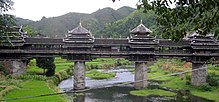Chengyang Bridge
Chengyang Yongji Bridge 程陽永濟橋 | |
|---|---|
 Chengyang Wind-Rain Bridge in 2003 | |
| Coordinates | 25°54′02″N 109°38′16″E / 25.9006°N 109.6378°E |
| Locale | Sanjiang County, Guangxi, China |
| Characteristics | |
| Design | Covered bridge |
| Total length | 64.4 m (211 ft) |
| Height | 10 m (33 ft) |
| No. of spans | 3 |
| History | |
| Construction end | 1912 |
| Opened | 1912 |
| Location | |
 | |
The Yongji Bridge of Chengyang (simplified Chinese: 程阳永济桥; traditional Chinese: 程陽永濟橋; pinyin: Chéngyáng Yǒngjì Qiáo), also called the Chengyang Wind and Rain Bridge (simplified Chinese: 程阳风雨桥; traditional Chinese: 程陽風雨橋; pinyin: Chéngyáng Fēngyǔ Qiáo), is a bridge in Sanjiang County,[1] of Guangxi, China.
Chengyang Bridge is a special covered bridge or lángqiáo, and one of several Fengyu bridges in the local Dong Minority region. It was completed in 1912.[citation needed] It is also called the Panlong Bridge (simplified Chinese: 盘龙桥; traditional Chinese: 盤龍橋; pinyin: Pánlóng Qiáo).
Properties[]
The bridge is a combination of bridge, corridor, veranda and Chinese pavilion. It has two platforms (one at each end of the bridge), 3 piers, 3 spans, 5 pavilions, 19 verandas, and three floors.[1] The piers are made of stone, the upper structures are mainly wooden, and the roof is covered with tiles. The bridge has wooden handrails on both sides.
The bridge has a total length of 64.4 metres (211 ft), and its corridor has a width of 3.4 metres (11 ft). The net height above the river is about 10 metres (33 ft).[2]
The bridge is located in Chengyang, and serves as the link between two populous villages.
Guo Moruo, a famous Chinese author, loved the bridge at first sight and wrote a poem for it.[2]

“程陽橋”, written by Guo Moruo

west of the bridge







south of the bridge



See also[]
- Xijin Bridge, another large covered bridge in Zhejiang, China.
References[]
| Wikimedia Commons has media related to Chengyang Yongji Bridge. |
- ^ Jump up to: a b "程阳桥 (Chengyang Bridge)" (in Chinese). Tuniu. 2006-04-23. Retrieved January 2, 2010.
- ^ Jump up to: a b "广西三江程阳风雨桥 (Guangxi Sanjiang Chengyang Wind-Rain Bridge)" (in Chinese). 中国网 (China.com.cn). 2002-05-21. Retrieved January 2, 2010.
- Bridges in Guangxi
- Covered bridges in China
- Chinese architectural history
- Major National Historical and Cultural Sites in Guangxi
- 1912 establishments in China
- Kam people












